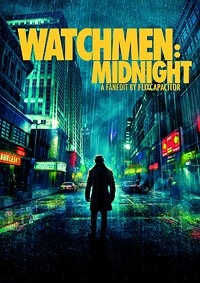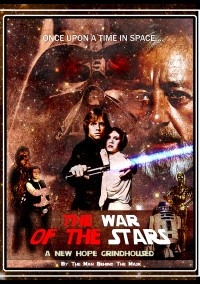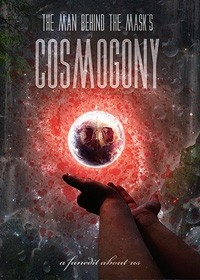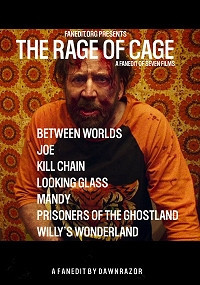Watchmen: Midnight
Updated: 2nd May 2024
| MRDb Rating | Your Rating | MRDb Chart | Views | Reviews | |
| No votes | Review to Rate | Not yet rated | 0 | 0 |
Faneditor: Flixcapacitor 
Fanedit Type: FanFix
Fanedit Release Date: 1st October 2011
Fanedit Runtime: 3h:35m:0s
Time Cut: 1h:0m:0s
Time Added: 0h:22m:0s
Franchise: DC
Genre: Action • Adventure • Drama • Romance • Sci-Fi • Superheroes
Original Title: Under the Hood (2009) Watchmen (2009)
Watchmen (2009) 
Original Release Date: 1st January 2009
Original Runtime: 4h:13m:0s
Certificate:
Format: Digital/DVD
Resolution:
Sound Mix:
Language:
Subtitles:



Fanedit Type: FanFix
Fanedit Release Date: 1st October 2011
Fanedit Runtime: 3h:35m:0s
Time Cut: 1h:0m:0s
Time Added: 0h:22m:0s
Franchise: DC
Genre: Action • Adventure • Drama • Romance • Sci-Fi • Superheroes
Original Title: Under the Hood (2009)
 Watchmen (2009)
Watchmen (2009) 
Original Release Date: 1st January 2009
Original Runtime: 4h:13m:0s
Certificate:
Format: Digital/DVD
Resolution:
Sound Mix:
Language:
Subtitles:


Synopsis:
WATCHMEN: MIDNIGHT is a fanedit crafted to recapture some of the spirit, story structure, and character depth of the original comic books by reorganizing/trimming scenes, adding new content from the “Under the Hood” documentary, replacing music to change the tone of various scenes, as well as cutting out silly stunts and other material that did not fit the tone of the original comics.
WATCHMEN: MIDNIGHT is a fanedit crafted to recapture some of the spirit, story structure, and character depth of the original comic books by reorganizing/trimming scenes, adding new content from the “Under the Hood” documentary, replacing music to change the tone of various scenes, as well as cutting out silly stunts and other material that did not fit the tone of the original comics.
Intentions:
My intention for WATCHMEN: MIDNIGHT has been to work with available materials to make this film adaptation more closely resemble the original comics, recognizing that it can never be a perfect 1:1 translation. Since its first publication, Hollywood producers wanted to adapt Alan Moore and Dave Gibbons’s WATCHMEN (1986-1987) comics for the screen. Dissatisfied with past adaptations of his work, Moore refused any association with a WATCHMEN film and has argued that Hollywood has a detrimental effect on the comics industry: "There are three or four companies now that exist for the sole purpose of creating not comics, but storyboards for films. It may be true that the only reason the comic book industry now exists is for this purpose, to create characters for movies, board games and other types of merchandise. Comics are just a sort of pumpkin patch growing franchises that might be profitable for the ailing movie industry." (Alan Moore, 2008) Although Zack Snyder’s production of WATCHMEN (2009) was billed as a faithful treatment and its design was uncannily similar to the world drawn by Dave Gibbons, there were significant alterations made to Moore’s characters and story, including a fundamental change to the genocidal plot and the climactic scene. Regardless of the degree of its authenticity, Snyder maintains: "I couldn’t be prouder of the movie. It’s exactly as I intended it. I don’t get it anymore, but I think people have seen the reality. I used to get “Oh you changed the book. It’s not 100% pure ‘Watchmen.’” And I’d say, “Are you kidding me? Are you crazy?” “300? allowed me to make this movie exactly how I wanted it. I had a stranglehold on the studio that allowed me to make a super-personal love letter to that graphic novel. It’s funny that Alan Moore has said he’s against “Watchmen” the movie. But it’s the strictest rendering of his work, by far, in movie form … I’m incredibly proud of it and I wouldn’t change it at all." (Zack Snyder, 2012) However, Snyder has already changed his film. WATCHMEN was released in three commercial versions: the theatrical cut (162 minutes), the “Director’s Cut” (186 minutes), and the “Ultimate Cut” (215 minutes). With each iteration, WATCHMEN grew closer to the nature of its source material but there were still many aspects of this adaptation that missed the mark. I resolved to make a new cut of WATCHMEN that might be a closer adaptation of the original comics.
My intention for WATCHMEN: MIDNIGHT has been to work with available materials to make this film adaptation more closely resemble the original comics, recognizing that it can never be a perfect 1:1 translation. Since its first publication, Hollywood producers wanted to adapt Alan Moore and Dave Gibbons’s WATCHMEN (1986-1987) comics for the screen. Dissatisfied with past adaptations of his work, Moore refused any association with a WATCHMEN film and has argued that Hollywood has a detrimental effect on the comics industry: "There are three or four companies now that exist for the sole purpose of creating not comics, but storyboards for films. It may be true that the only reason the comic book industry now exists is for this purpose, to create characters for movies, board games and other types of merchandise. Comics are just a sort of pumpkin patch growing franchises that might be profitable for the ailing movie industry." (Alan Moore, 2008) Although Zack Snyder’s production of WATCHMEN (2009) was billed as a faithful treatment and its design was uncannily similar to the world drawn by Dave Gibbons, there were significant alterations made to Moore’s characters and story, including a fundamental change to the genocidal plot and the climactic scene. Regardless of the degree of its authenticity, Snyder maintains: "I couldn’t be prouder of the movie. It’s exactly as I intended it. I don’t get it anymore, but I think people have seen the reality. I used to get “Oh you changed the book. It’s not 100% pure ‘Watchmen.’” And I’d say, “Are you kidding me? Are you crazy?” “300? allowed me to make this movie exactly how I wanted it. I had a stranglehold on the studio that allowed me to make a super-personal love letter to that graphic novel. It’s funny that Alan Moore has said he’s against “Watchmen” the movie. But it’s the strictest rendering of his work, by far, in movie form … I’m incredibly proud of it and I wouldn’t change it at all." (Zack Snyder, 2012) However, Snyder has already changed his film. WATCHMEN was released in three commercial versions: the theatrical cut (162 minutes), the “Director’s Cut” (186 minutes), and the “Ultimate Cut” (215 minutes). With each iteration, WATCHMEN grew closer to the nature of its source material but there were still many aspects of this adaptation that missed the mark. I resolved to make a new cut of WATCHMEN that might be a closer adaptation of the original comics.
Change List:
This list covers the latest 2014 version of the fanedit released on the fifth anniversary of the theatrical debut of Zack Snyder’s film. WATCHMEN: MIDNIGHT was mainly sourced from the “Ultimate Cut” which retained most of the scene extensions of the “Director’s Cut” and it incorporated a version of the animated Tales of the Black Freighter with new live action scenes featuring the two Bernies at the newsstand in an attempt to bridge both narratives. Snyder considers the “Ultimate Cut” to be more of an experimental version rather than his definitive cut, and as I have previously explained, the positions of Tales of the Black Freighter in the the narrative of the “Ultimate Cut” is problematic. Once I recut the main narrative of WATCHMEN to more closely follow the story structure of the comics it became possible to re-incorporate Tales of the Black Freighter in a more appropriate fashion to appreciate the thematic and emotional parallels between these narratives. Chapter 1: At Midnight, All the Agents… • Added moody opening samples from “The Comedian is Dead” and “Dan’s Apocalyptic Dream” from the Tyler Bates’s original score. • Restored 1980s-era DC logo and rotated it so the stars are North-South-East-West as on the covers of the WATCHMEN comics. • Removed scene in The Comedian’s apartment of television watching or fight with mystery man. Instead, the opening logos segue into vertical pull-back shot from smiley pin on the street to Comedian’s apartment. • Intercut flashbacks to attacker kicking in the door and throwing Comedian out the window during police detective speculations. This scene is significantly shorter in all filmed versions than in the comic, so not as many flashbacks were possible. The booming shot from the street level to the high-rise apartment is unfortunately too short to add Rorschach’s narration. • Added new “WATCHMEN” title superimposed over shot of New York skyline. • Added Chapter 1 title card: “Tonight, all the agents…” when Rorschach enters Blake’s apartment, approximating its appearance in the comics. • Removed Rorschach’s fight with police, so there is no longer an awkward moment with a police officer shooting and missing Rorschach at short range. • Removed mention of Rorschach when Dan Dreiberg/Nite Owl II visits Hollis Mason. • Removed Dan’s reference to Rorschach on television back at his brownstone house. • Removed Dan and Rorschach dialogue: “Watchmen are over” / “Says tricky Dick” / “Says me.” This removes an instance where the group is actually called “The Watchmen.” Now Rorschach suggests fighting back against the mask killer but Dan silently rebukes Rorschach before reminding him that he could retire with anonymity. • Trimmed first part of Dan visiting Adrian Veidt/Ozymandias — fade to black with Rorschach walking on street with narration about “so little time…” and fade in with close-up of newspaper headline “Doomsday” and “Midnight” etc. Used second half of the scene between Dan and Adrian, thereby removing an awkward scene with journalists and several mentions of “the Watchmen.” • Added Chapter 1 end-quote after Dan says, “The Comedian is dead.” • Added first Under the Hood segment, which makes a thematic bridge from optimism of the 1940s Minutemen to the somber aftermath at The Comedian’s funeral in the 1980s. Chapter 2: Absent Friends • Replaced Simon and Garfunkel song “The Sounds of Silence” at Blake’s funeral with the Philip Glass song, “New World” from the Naqoyqatsi (2002) film score. The Simon and Garfunkel song is distractingly reminiscent of The Graduate (1967) and seems too sentimental for the way the characters remember the Comedian. The new Philip Glass song also introduces some of the musical themes that will play at the end of the film, after the genocidal plot has succeeded; in a way, the death of the Comedian is the first step toward orchestrating Ozymandias’s “new world.” • Added Chapter 2 title: “Absent friends” when the casket is lowered into the ground, approximating its appearance in the comics. • Replaced Richard Wagner song “Ride of the Valkyries” with excerpts from Tyler Bates’s songs “Who Murdered Hollis Mason?” and “Dan’s Apocalyptic Dream” from the WATCHMEN score because the Wagner song is a distracting homage to Apocalypse Now (1979). The twisted glee of the Wagner song might have been appropriate if the scene came from the Comedian’s memory, but this scene was Dr. Manhattan’s reminiscence. The chaotic Vietnam scenes establish Dr. Manhattan’s increasing disaffection with the human race, but the use of the Wagner song in the original version added misplaced humor to what should be a horrifying sequence. The irony of heroism and massacre in the use of the Wagner song worked in Apocalypse Now, but it was misused in WATCHMEN — film audiences often laughed during the scene when it screened in cinemas and they were probably reminded of the Looney Toons operatic “Kill the Wabbit” cartoon. With new music, this scene resembles something more like a nightmare. Sound effects of exploding people and cries for help are intentionally removed to emphasize the altered state of memory. • Removed Comedian’s over-the-top line: “Medic!!” from the Vietnam flashback. • Removed Comedian’s line that references “the Watchmen” as a group name during Adrian’s flashback. • Added Chapter 2 end-quote after flashback of the Comedian falling during the Rorschach voice-over. • Added second Under the Hood segment which ends with Culpepper asking a rhetorical question about whether Mason had the right to take law in to his own hands. This creates a segue into the question of Dr. Manhattan’s personal and political responsibilities in the following chapter. Chapter 3: The Judge of All the Earth • Opens with the first Tale of the Black Freighter segment. • Added chapter title: “The Judge of All the Earth” during the scene with two Bernies at the newsstand, approximating its appearance in the comics. • Recut the sequence according to the comics, thus returning to Tales of the Black Freighter after the elder Bernie’s interruption. This is contrary to the “Ultimate Cut” of WATCHMEN on DVD/Blu-ray, which does not continue the animated narrative until later in the film and does not follow the same narrative order as the comics. • Inspired by the comics, created visual parallels between the sailor caressing the ship’s figurehead in Tales of the Black Freighter and Dr. Manhattan/Laurie’s intimate moment at home as we transition back to the main narrative. • Trimmed gore and cartoony violence/stunts during Dan and Laurie Juspeczyk’s fight with the Knot-Top gang. • Removed Laurie’s line, “It’s a tough world out there,” after fighting with knot-tops in order to smooth out the transition to the following scene where Dan visits Hollis Mason. In the subsequent scene, Mason mentions Dr. Manhattan losing it on live television, then cut to: scene on street corner of a man complaining about Dr. Manhattan disappearing from Earth. The sequence continues to the scene with Laurie arguing with government agents about Dr. Manhattan and includes her flashback to first New Minutemen meeting. This sequence concludes with Richard Nixon’s first appearance in the film since the prologue attack scene at the Comedian’s apartment was removed. • Added Chapter 3 end-quote after Nixon says things are in the hands of a higher power. • Added third Under the Hood segment which ends with Sally Jupiter saying it was important to know when to retire/move on/etc… This segues into the next chapter dealing with Dr. Manhattan choosing to retire from humanity and leave Earth. Chapter 4: Watchmaker • Opens with Dr. Manhattan landing on Mars. • Added Chapter 4 title card: “Watchmaker” when Dr. Manhattan starts to remember his past. • Trimmed gratuitous gore in mobster restaurant when Dr. Manhattan causes a man to explode. • Added Chapter 4 end-title after Dr. Manhattan says, “Too late.” • Added fourth Under the Hood segment which ends with the Psychiatrist discussing the human qualities of masked heroes, including hopes, desires, and love. This connects with the romantic relationships of Dr. Manhattan, as well as the romance between the Nite Owls and Silk Spectres. The psychiatrist also expresses concern about the “borderline sociopaths” who actually think they are doing good for the world, as well as his desire to psycho-analyze one of them. This connects with the Adrian’s meeting with the industrialists where he expresses his altruistic goals and eventually the Psychiatrist’s unsatisfying interview with Rorschach. Chapter 5: Fearful Symmetry • Opens with a Tales of the Black Freighter segment in which the sea captain builds a raft from dead bodies and the bloodstain on his sail resembles a Rorschach inkblot. This segment ends with the sea captain taking a bite from a dead seagull. • Added Chapter 5 title card: “Fearful Symmetry” during Adrian’s meeting with the industrialists. • Removed the gratuitous shot of the secretary’s hand exploding during the assassination attempt on Adrian. • Added the next Tales of the Black Freighter segment. The preceding scene in the main narrative ends with the assassin vomiting foam from a poison capsule, and this Tales of the Black Freighter segment begins with the sea captain vomiting after eating the seagull, thinking about how human beings “exist on the whim of murderers.” This connects with the eventual revelation that Adrian orchestrated a fake assassination attempt and was responsible for the deaths of many more people. We can also compare the sea captain’s cry that he would “give his life for nobility” to Ozymandias’s belief that his hired assassin and the team of scientists in Antarctica all sacrificed their lives for his honor, their idealized Pharaoh. This segment concludes with the corpse of the ship’s first mate telling the sea captain that his attempts to save his family are futile, that he will fail. This also connects to the main narrative because in the next scene with Dan and Laurie at the Gunga Diner, Dan explains that Adrian’s would-be assassin was “dead before he hit the ground.” • Added Chapter 5 end-quote after Rorschach is unmasked. The audio during this end-quote comes from a television news report about Rorschach’s arrest, revealing his birth name. This is is the best approximation of the supplemental documents about Rorschach provided at the end of this issue in the comics. Chapter 6: The Abyss Gazes Also • Added Chapter 6 title card: “The Abyss Gazes Also” during Rorschach’s meeting with the Psychiatrist, approximating its appearance in the comics. • Trimmed gratuitous violence during Rorschach’s flashback about the child killer. The final swing with meat cleaver makes a sound-bridge back to Rorschach in present day. • Added Chapter 6 end-quote after Rorschach’s fight in the prison cafeteria. • Added the final Under the Hood segment in which Hollis Mason muses about his unrequited love for Sally Jupiter. This connects with the following chapter in which their crime fighter successors, Dan and Laurie, finally express love for each other. Chapter 7: A Brother to Dragons • Opens with Big Figure taunting Rorschach in prison. In the comics, this scene appears in the following chapter and is intercut with a scene in which a police detective questions Dan at home. The questioning scene was not filmed or otherwise does not appear in Zack Snyder’s WATCHMEN, so its appearance in the film is unchanged, maintaining the tension that Rorschach is facing in prison before Dan and Laurie decide to break him out. • Added Chapter 7 title card: “A Brother to Dragons” when Dan extinguishes the fire set by Laurie outside the Owl Ship. • Trimmed the scene in which Laurie tries on Dan’s goggles. In this version, the goggles do not digitally scan fingerprints. • Added fade out after first lovemaking attempt between Dan and Laurie, then cut to: Dan’s apocalyptic nightmare, then cut to: Laurie finding Dan naked in basement. No other scenes are intercut with this segment and thus it proceeds more like the comic book. • Removed little girl’s bad line reading of “Is that Jesus?” during building evacuation. The scene replaced by version of the rescue from the theatrical cut of the film. • In all the official film versions of WATCHMEN, Silk Spectre II falls backward twice in the Owl ship after the building explosion. This mistake has been corrected in WATCHMEN: MIDNIGHT. • Significantly trimmed down the sex scene in the Owl ship. After dropping off the rescued people, Dan and Laurie originally shared some ineffectual dialogue before a smarmy and overlong sex scene. In this version, Dan acts on his sexually confidence after they drop off the rescued people by putting the ship into auto-pilot and kissing Laurie. They undress and begin to embrace, but the scene ends with the ship hovering in the air. The sex is implied, and it’s rather romantic. The Leonard Cohen “Hallelujah” song has been replaced with a piece of the Tyler Bates song “We’ll Live Longer” from the WATCHMEN score. This music theme originally plays during Dan and Laurie’s dinner date in Chapter 1, and it serves to round out their romance. • Added Chapter 7 end-title after the lovemaking scene. The quote from the Book of Job mentions “my bones are burned with heat,” and this connects nicely with the following chapter, in which the action is triggered by the death of the prison inmate that Rorschach burned in the cafeteria line. Chapter 8: Old Ghosts • Opens with a segment from Tales of the Black Freighter, in which the sea captain fights off sharks. The segment ends with the sea captain falling, near death, to the ocean floor. This potentially connects to the death of the burned prison inmate, while the sea captain’s visions of his hometown devastated by the Black Freighter’s crew and encroaching figures of death may foreshadow the horror of Ozymandias’s devious plan and Rorschach’s fatal refusal to comply. • Removed the establishing shot of prison riot because of an awkwardly executed bit with a stuntman on fire. • Added Chapter 8 title: “Old Ghosts” during arm severing scene and trimmed down gratuitous gore. In the original comics, the chapter title appeared with panels of trick-or-treating children outside Hollis Mason’s house, but these were not included in the film adaptation. • Removed the big fight between Nite Owl II and Silk Spectre II and the prison inmates. In the comics, the scene had just one punch, and so in this version Silk Spectre II simply punches an overzealous prison guard. • Near the newsstand on the street, the Knot-tops talk about going after Hollis Mason, then cut to: Mason telephoning Sally about the reunion of Nite Owl and Silk Spectre that night. • Added Chapter 8 end-quote after the knot-tops kill Hollis Mason. Chapter 9: The Darkness of Mere Being • Added Chapter 9 title card: “The Darkness of Mere Being” after Dr. Manhattan teleports with Silk Spectre II to Mars. • Edited together all of the Dr. Manhattan/Silk Spectre II scenes on Mars so it plays more like the comics. • Added Chapter 9 end-quote after the camera reveals the Galle (smiley face) crater on Mars. Chapter 10: Two Riders Were Approaching • Opens with a scene between the two Bernies at the newsstand. In the comics, there were more scenes involving the military gearing up for a nuclear strike but these were not included in the film. However, the newsstand scene does remind the viewer of the escalating political tensions with a newspaper headline, “Soviets Invade Afghanistan,” and the elder Bernie sighing, “God help us.” • That scene continues into a Tales of the Black Freighter segment in which the sea captain is washed ashore at his home port. His paranoid delusions of murderers during this sequence reflects some of the confusion of friends and foes at the heart of Rorschach’s suspicions and foreshadows the violence ahead for Rorschach and Nite Owl II when they pursue Ozymandias. The sequence ends with the sea captain fleeing from an angry mob after murdering his family, and the main narrative follows with Rorschach expressing frustration about “hiding from authorities.” • Added Chapter 10 title card: “Two Riders Were Approaching…” after Nite Owl II and Rorschach shake hands and decide solve the mystery together. • Trimmed gratuitous violence/obvious fake teeth close-up shot when Nite Owl II attacks the Knot Top. • Edited together all of the Nite Owl II/Rorschach sleuthing scenes so it’s more like the comics. This also moves the story forward rather than having an “A” storyline resolve itself while the “B” storyline (Silk Spectre II/ Dr. Manhattan on Mars) still trudges on. • Added Chapter 10 end-quote after Ozymandias notices Nite Owl II and Rorschach approaching his Antarctic compound in the video monitors. Chapter 11: Look On My Works, Ye Mighty… • Added Chapter 11 title card: “Look on my works, ye mighty…” when Nite Owl II and Rorschach break open the doors to the Antarctic compound. • Trimmed down superhuman martial arts during Rorschach/Nite Owl II/Ozymandias fight scene. • This chapter includes the final Tales of the Black Freighter segment, in which the sea captain realizes his defeat and accepts his fate aboard the Black Freighter. During this segment, the sea captain narrates: “How had I reached this appalling position with love, only love, as my guide? … Noble intentions had led me to atrocity. The righteous anger fueling my ingenious, awful scheme was but delusion. Where was my error? … And gradually I understood what innocent intent had brought me to … The unspeakable truth loomed, unavoidable, before me … All my well meaning plans had come to this. The world I tried to save was lost beyond recall … I was a horror; amongst horrors must I dwell.” This realization connects with the following chapter in which the main characters wrestle with their acceptance of Ozymandias’s genocidal plan — in disgust, Nite Owl II will remark: “You haven’t idealized mankind, you’ve deformed it, you’ve mutilated it. That’s your legacy. That’s the real practical joke.” Ozymandias will be left alone in his palace. • Added Chapter 11 end-quote after the attack on New York. Chapter 12: A Stronger Loving World • Removed Nixon/Kissinger scene in War Room because it is redundant — we already know that it was supposedly Dr. Manhattan’s energy signature because Ozymandias already explained his plan, and eventually Nixon reveals this same information to the public during the television address he makes. • Added Chapter 12 title card: “A stronger loving world” when Dr. Manhattan and Silk Specture II survey the wreckage in New York. • Cut Rorschach’s narration: “Tonight, a Comedian died in New York…” so the scene plays more like the comic. • Added Chapter 12 end-quote and “Who watches the watchmen?” Latin quote. • Added revised slow-motion title sequence with “The Beginning is the End is the Beginning” by The Smashing Pumpkins. Also replaced the My Chemical Romance song during end credits with Philip Glass songs chapter “Massman” and “New World” from the Naqoyqatsi film score.
This list covers the latest 2014 version of the fanedit released on the fifth anniversary of the theatrical debut of Zack Snyder’s film. WATCHMEN: MIDNIGHT was mainly sourced from the “Ultimate Cut” which retained most of the scene extensions of the “Director’s Cut” and it incorporated a version of the animated Tales of the Black Freighter with new live action scenes featuring the two Bernies at the newsstand in an attempt to bridge both narratives. Snyder considers the “Ultimate Cut” to be more of an experimental version rather than his definitive cut, and as I have previously explained, the positions of Tales of the Black Freighter in the the narrative of the “Ultimate Cut” is problematic. Once I recut the main narrative of WATCHMEN to more closely follow the story structure of the comics it became possible to re-incorporate Tales of the Black Freighter in a more appropriate fashion to appreciate the thematic and emotional parallels between these narratives. Chapter 1: At Midnight, All the Agents… • Added moody opening samples from “The Comedian is Dead” and “Dan’s Apocalyptic Dream” from the Tyler Bates’s original score. • Restored 1980s-era DC logo and rotated it so the stars are North-South-East-West as on the covers of the WATCHMEN comics. • Removed scene in The Comedian’s apartment of television watching or fight with mystery man. Instead, the opening logos segue into vertical pull-back shot from smiley pin on the street to Comedian’s apartment. • Intercut flashbacks to attacker kicking in the door and throwing Comedian out the window during police detective speculations. This scene is significantly shorter in all filmed versions than in the comic, so not as many flashbacks were possible. The booming shot from the street level to the high-rise apartment is unfortunately too short to add Rorschach’s narration. • Added new “WATCHMEN” title superimposed over shot of New York skyline. • Added Chapter 1 title card: “Tonight, all the agents…” when Rorschach enters Blake’s apartment, approximating its appearance in the comics. • Removed Rorschach’s fight with police, so there is no longer an awkward moment with a police officer shooting and missing Rorschach at short range. • Removed mention of Rorschach when Dan Dreiberg/Nite Owl II visits Hollis Mason. • Removed Dan’s reference to Rorschach on television back at his brownstone house. • Removed Dan and Rorschach dialogue: “Watchmen are over” / “Says tricky Dick” / “Says me.” This removes an instance where the group is actually called “The Watchmen.” Now Rorschach suggests fighting back against the mask killer but Dan silently rebukes Rorschach before reminding him that he could retire with anonymity. • Trimmed first part of Dan visiting Adrian Veidt/Ozymandias — fade to black with Rorschach walking on street with narration about “so little time…” and fade in with close-up of newspaper headline “Doomsday” and “Midnight” etc. Used second half of the scene between Dan and Adrian, thereby removing an awkward scene with journalists and several mentions of “the Watchmen.” • Added Chapter 1 end-quote after Dan says, “The Comedian is dead.” • Added first Under the Hood segment, which makes a thematic bridge from optimism of the 1940s Minutemen to the somber aftermath at The Comedian’s funeral in the 1980s. Chapter 2: Absent Friends • Replaced Simon and Garfunkel song “The Sounds of Silence” at Blake’s funeral with the Philip Glass song, “New World” from the Naqoyqatsi (2002) film score. The Simon and Garfunkel song is distractingly reminiscent of The Graduate (1967) and seems too sentimental for the way the characters remember the Comedian. The new Philip Glass song also introduces some of the musical themes that will play at the end of the film, after the genocidal plot has succeeded; in a way, the death of the Comedian is the first step toward orchestrating Ozymandias’s “new world.” • Added Chapter 2 title: “Absent friends” when the casket is lowered into the ground, approximating its appearance in the comics. • Replaced Richard Wagner song “Ride of the Valkyries” with excerpts from Tyler Bates’s songs “Who Murdered Hollis Mason?” and “Dan’s Apocalyptic Dream” from the WATCHMEN score because the Wagner song is a distracting homage to Apocalypse Now (1979). The twisted glee of the Wagner song might have been appropriate if the scene came from the Comedian’s memory, but this scene was Dr. Manhattan’s reminiscence. The chaotic Vietnam scenes establish Dr. Manhattan’s increasing disaffection with the human race, but the use of the Wagner song in the original version added misplaced humor to what should be a horrifying sequence. The irony of heroism and massacre in the use of the Wagner song worked in Apocalypse Now, but it was misused in WATCHMEN — film audiences often laughed during the scene when it screened in cinemas and they were probably reminded of the Looney Toons operatic “Kill the Wabbit” cartoon. With new music, this scene resembles something more like a nightmare. Sound effects of exploding people and cries for help are intentionally removed to emphasize the altered state of memory. • Removed Comedian’s over-the-top line: “Medic!!” from the Vietnam flashback. • Removed Comedian’s line that references “the Watchmen” as a group name during Adrian’s flashback. • Added Chapter 2 end-quote after flashback of the Comedian falling during the Rorschach voice-over. • Added second Under the Hood segment which ends with Culpepper asking a rhetorical question about whether Mason had the right to take law in to his own hands. This creates a segue into the question of Dr. Manhattan’s personal and political responsibilities in the following chapter. Chapter 3: The Judge of All the Earth • Opens with the first Tale of the Black Freighter segment. • Added chapter title: “The Judge of All the Earth” during the scene with two Bernies at the newsstand, approximating its appearance in the comics. • Recut the sequence according to the comics, thus returning to Tales of the Black Freighter after the elder Bernie’s interruption. This is contrary to the “Ultimate Cut” of WATCHMEN on DVD/Blu-ray, which does not continue the animated narrative until later in the film and does not follow the same narrative order as the comics. • Inspired by the comics, created visual parallels between the sailor caressing the ship’s figurehead in Tales of the Black Freighter and Dr. Manhattan/Laurie’s intimate moment at home as we transition back to the main narrative. • Trimmed gore and cartoony violence/stunts during Dan and Laurie Juspeczyk’s fight with the Knot-Top gang. • Removed Laurie’s line, “It’s a tough world out there,” after fighting with knot-tops in order to smooth out the transition to the following scene where Dan visits Hollis Mason. In the subsequent scene, Mason mentions Dr. Manhattan losing it on live television, then cut to: scene on street corner of a man complaining about Dr. Manhattan disappearing from Earth. The sequence continues to the scene with Laurie arguing with government agents about Dr. Manhattan and includes her flashback to first New Minutemen meeting. This sequence concludes with Richard Nixon’s first appearance in the film since the prologue attack scene at the Comedian’s apartment was removed. • Added Chapter 3 end-quote after Nixon says things are in the hands of a higher power. • Added third Under the Hood segment which ends with Sally Jupiter saying it was important to know when to retire/move on/etc… This segues into the next chapter dealing with Dr. Manhattan choosing to retire from humanity and leave Earth. Chapter 4: Watchmaker • Opens with Dr. Manhattan landing on Mars. • Added Chapter 4 title card: “Watchmaker” when Dr. Manhattan starts to remember his past. • Trimmed gratuitous gore in mobster restaurant when Dr. Manhattan causes a man to explode. • Added Chapter 4 end-title after Dr. Manhattan says, “Too late.” • Added fourth Under the Hood segment which ends with the Psychiatrist discussing the human qualities of masked heroes, including hopes, desires, and love. This connects with the romantic relationships of Dr. Manhattan, as well as the romance between the Nite Owls and Silk Spectres. The psychiatrist also expresses concern about the “borderline sociopaths” who actually think they are doing good for the world, as well as his desire to psycho-analyze one of them. This connects with the Adrian’s meeting with the industrialists where he expresses his altruistic goals and eventually the Psychiatrist’s unsatisfying interview with Rorschach. Chapter 5: Fearful Symmetry • Opens with a Tales of the Black Freighter segment in which the sea captain builds a raft from dead bodies and the bloodstain on his sail resembles a Rorschach inkblot. This segment ends with the sea captain taking a bite from a dead seagull. • Added Chapter 5 title card: “Fearful Symmetry” during Adrian’s meeting with the industrialists. • Removed the gratuitous shot of the secretary’s hand exploding during the assassination attempt on Adrian. • Added the next Tales of the Black Freighter segment. The preceding scene in the main narrative ends with the assassin vomiting foam from a poison capsule, and this Tales of the Black Freighter segment begins with the sea captain vomiting after eating the seagull, thinking about how human beings “exist on the whim of murderers.” This connects with the eventual revelation that Adrian orchestrated a fake assassination attempt and was responsible for the deaths of many more people. We can also compare the sea captain’s cry that he would “give his life for nobility” to Ozymandias’s belief that his hired assassin and the team of scientists in Antarctica all sacrificed their lives for his honor, their idealized Pharaoh. This segment concludes with the corpse of the ship’s first mate telling the sea captain that his attempts to save his family are futile, that he will fail. This also connects to the main narrative because in the next scene with Dan and Laurie at the Gunga Diner, Dan explains that Adrian’s would-be assassin was “dead before he hit the ground.” • Added Chapter 5 end-quote after Rorschach is unmasked. The audio during this end-quote comes from a television news report about Rorschach’s arrest, revealing his birth name. This is is the best approximation of the supplemental documents about Rorschach provided at the end of this issue in the comics. Chapter 6: The Abyss Gazes Also • Added Chapter 6 title card: “The Abyss Gazes Also” during Rorschach’s meeting with the Psychiatrist, approximating its appearance in the comics. • Trimmed gratuitous violence during Rorschach’s flashback about the child killer. The final swing with meat cleaver makes a sound-bridge back to Rorschach in present day. • Added Chapter 6 end-quote after Rorschach’s fight in the prison cafeteria. • Added the final Under the Hood segment in which Hollis Mason muses about his unrequited love for Sally Jupiter. This connects with the following chapter in which their crime fighter successors, Dan and Laurie, finally express love for each other. Chapter 7: A Brother to Dragons • Opens with Big Figure taunting Rorschach in prison. In the comics, this scene appears in the following chapter and is intercut with a scene in which a police detective questions Dan at home. The questioning scene was not filmed or otherwise does not appear in Zack Snyder’s WATCHMEN, so its appearance in the film is unchanged, maintaining the tension that Rorschach is facing in prison before Dan and Laurie decide to break him out. • Added Chapter 7 title card: “A Brother to Dragons” when Dan extinguishes the fire set by Laurie outside the Owl Ship. • Trimmed the scene in which Laurie tries on Dan’s goggles. In this version, the goggles do not digitally scan fingerprints. • Added fade out after first lovemaking attempt between Dan and Laurie, then cut to: Dan’s apocalyptic nightmare, then cut to: Laurie finding Dan naked in basement. No other scenes are intercut with this segment and thus it proceeds more like the comic book. • Removed little girl’s bad line reading of “Is that Jesus?” during building evacuation. The scene replaced by version of the rescue from the theatrical cut of the film. • In all the official film versions of WATCHMEN, Silk Spectre II falls backward twice in the Owl ship after the building explosion. This mistake has been corrected in WATCHMEN: MIDNIGHT. • Significantly trimmed down the sex scene in the Owl ship. After dropping off the rescued people, Dan and Laurie originally shared some ineffectual dialogue before a smarmy and overlong sex scene. In this version, Dan acts on his sexually confidence after they drop off the rescued people by putting the ship into auto-pilot and kissing Laurie. They undress and begin to embrace, but the scene ends with the ship hovering in the air. The sex is implied, and it’s rather romantic. The Leonard Cohen “Hallelujah” song has been replaced with a piece of the Tyler Bates song “We’ll Live Longer” from the WATCHMEN score. This music theme originally plays during Dan and Laurie’s dinner date in Chapter 1, and it serves to round out their romance. • Added Chapter 7 end-title after the lovemaking scene. The quote from the Book of Job mentions “my bones are burned with heat,” and this connects nicely with the following chapter, in which the action is triggered by the death of the prison inmate that Rorschach burned in the cafeteria line. Chapter 8: Old Ghosts • Opens with a segment from Tales of the Black Freighter, in which the sea captain fights off sharks. The segment ends with the sea captain falling, near death, to the ocean floor. This potentially connects to the death of the burned prison inmate, while the sea captain’s visions of his hometown devastated by the Black Freighter’s crew and encroaching figures of death may foreshadow the horror of Ozymandias’s devious plan and Rorschach’s fatal refusal to comply. • Removed the establishing shot of prison riot because of an awkwardly executed bit with a stuntman on fire. • Added Chapter 8 title: “Old Ghosts” during arm severing scene and trimmed down gratuitous gore. In the original comics, the chapter title appeared with panels of trick-or-treating children outside Hollis Mason’s house, but these were not included in the film adaptation. • Removed the big fight between Nite Owl II and Silk Spectre II and the prison inmates. In the comics, the scene had just one punch, and so in this version Silk Spectre II simply punches an overzealous prison guard. • Near the newsstand on the street, the Knot-tops talk about going after Hollis Mason, then cut to: Mason telephoning Sally about the reunion of Nite Owl and Silk Spectre that night. • Added Chapter 8 end-quote after the knot-tops kill Hollis Mason. Chapter 9: The Darkness of Mere Being • Added Chapter 9 title card: “The Darkness of Mere Being” after Dr. Manhattan teleports with Silk Spectre II to Mars. • Edited together all of the Dr. Manhattan/Silk Spectre II scenes on Mars so it plays more like the comics. • Added Chapter 9 end-quote after the camera reveals the Galle (smiley face) crater on Mars. Chapter 10: Two Riders Were Approaching • Opens with a scene between the two Bernies at the newsstand. In the comics, there were more scenes involving the military gearing up for a nuclear strike but these were not included in the film. However, the newsstand scene does remind the viewer of the escalating political tensions with a newspaper headline, “Soviets Invade Afghanistan,” and the elder Bernie sighing, “God help us.” • That scene continues into a Tales of the Black Freighter segment in which the sea captain is washed ashore at his home port. His paranoid delusions of murderers during this sequence reflects some of the confusion of friends and foes at the heart of Rorschach’s suspicions and foreshadows the violence ahead for Rorschach and Nite Owl II when they pursue Ozymandias. The sequence ends with the sea captain fleeing from an angry mob after murdering his family, and the main narrative follows with Rorschach expressing frustration about “hiding from authorities.” • Added Chapter 10 title card: “Two Riders Were Approaching…” after Nite Owl II and Rorschach shake hands and decide solve the mystery together. • Trimmed gratuitous violence/obvious fake teeth close-up shot when Nite Owl II attacks the Knot Top. • Edited together all of the Nite Owl II/Rorschach sleuthing scenes so it’s more like the comics. This also moves the story forward rather than having an “A” storyline resolve itself while the “B” storyline (Silk Spectre II/ Dr. Manhattan on Mars) still trudges on. • Added Chapter 10 end-quote after Ozymandias notices Nite Owl II and Rorschach approaching his Antarctic compound in the video monitors. Chapter 11: Look On My Works, Ye Mighty… • Added Chapter 11 title card: “Look on my works, ye mighty…” when Nite Owl II and Rorschach break open the doors to the Antarctic compound. • Trimmed down superhuman martial arts during Rorschach/Nite Owl II/Ozymandias fight scene. • This chapter includes the final Tales of the Black Freighter segment, in which the sea captain realizes his defeat and accepts his fate aboard the Black Freighter. During this segment, the sea captain narrates: “How had I reached this appalling position with love, only love, as my guide? … Noble intentions had led me to atrocity. The righteous anger fueling my ingenious, awful scheme was but delusion. Where was my error? … And gradually I understood what innocent intent had brought me to … The unspeakable truth loomed, unavoidable, before me … All my well meaning plans had come to this. The world I tried to save was lost beyond recall … I was a horror; amongst horrors must I dwell.” This realization connects with the following chapter in which the main characters wrestle with their acceptance of Ozymandias’s genocidal plan — in disgust, Nite Owl II will remark: “You haven’t idealized mankind, you’ve deformed it, you’ve mutilated it. That’s your legacy. That’s the real practical joke.” Ozymandias will be left alone in his palace. • Added Chapter 11 end-quote after the attack on New York. Chapter 12: A Stronger Loving World • Removed Nixon/Kissinger scene in War Room because it is redundant — we already know that it was supposedly Dr. Manhattan’s energy signature because Ozymandias already explained his plan, and eventually Nixon reveals this same information to the public during the television address he makes. • Added Chapter 12 title card: “A stronger loving world” when Dr. Manhattan and Silk Specture II survey the wreckage in New York. • Cut Rorschach’s narration: “Tonight, a Comedian died in New York…” so the scene plays more like the comic. • Added Chapter 12 end-quote and “Who watches the watchmen?” Latin quote. • Added revised slow-motion title sequence with “The Beginning is the End is the Beginning” by The Smashing Pumpkins. Also replaced the My Chemical Romance song during end credits with Philip Glass songs chapter “Massman” and “New World” from the Naqoyqatsi film score.
Additional Notes:
Scenes from WATCHMEN have been reorganized to more closely represent the narrative structure of the comic book, with each “chapter” framed by its corresponding inter-titles and quotations. The quotation shots with animated clock motif have been drawn from WATCHMEN: THE MOTION COMIC (2008-2009) and the new inter-titles are inspired by their appearances in the comics. Instances of “super human” feats by mortal characters and gratuitous gore have been trimmed. Using the comic books as a guide, many scenes have been re-edited or removed. For example, the prison fight scene with Nite Owl II and Silk Spectre II has been completely removed and their lovemaking scene has been heavily trimmed. Other subtle and significant changes are made throughout the film, for example: Nite Owl II’s goggles no longer scan fingerprints and instances where characters are actually referred to as the “Watchmen” have been removed. Certain scenes have new music cues in order to alter tone or avoid inappropriate film references, such as the Comedian’s funeral, Dr. Manhattan’s Vietnam flashback, and the lovemaking scene. The original versions of WATCHMEN borrow music from the Koyaanisqatsi (1982) film score by Philip Glass, and additional music for WATCHMEN: MIDNIGHT comes from his Naqoyqatsi (2002) film score. Many of the pop songs have been replaced in order to maintain a tone for the film, except for a few songs that are appropriate for scenes and respective historical periods, such as “99 Luftballoons” for the 1980s and “I’m Your Boogie Man” for the 1970s. Re-edited segments from the Under the Hood (2009) mockumentary have been composited into shots of Hollis Mason’s television set; these are presented in the film as if they are being viewed by Mason on an old video tape. Similar to the “Under the Hood” excerpts and other diegetic documents at the end of each issue of the original comic, these segments provide a great deal of character back-story, draw parallels between characters, and act as meditations on the larger themes of WATCHMEN. The “Ultimate Cut” of WATCHMEN on DVD/Blu-ray included a segmented version of the animated Tales of the Black Freighter (2009) but its appearance was less effective because the original film deviated from the comic book narrative structure. The 2011 version of WATCHMEN: MIDNIGHT did not include any portions of Tales of the Black Freighter because I initially opposed the use of animation for representing the comic-within-the-comic. Later, I learned that director Zack Snyder originally intended to produce these sequences in a visual style reminiscent of his film 300 (2006) but the projected budget of $20 million made a 300-style Tales of the Black Freighter cost prohibitive. Synder’s compromise was animation.3 Realizing that Tales of the Black Freighter is integral to WATCHMEN, I have re-incorporated it into the fanedit based on their appearance in the comics in order to provide a more accurate representation of these juxtaposed narratives. The original slow-motion opening credits sequence has been moved from the start of the film and placed at the end. Now the film begins with the smiley face pin as in the comics. A new opening title appears super-imposed over a wide shot of the New York skyline after the police detectives search the Comedian’s apartment. At the end of the film, after the final chapter quotation, the slow-motion credits sequence serves as the beginning of the end credits. Music for this elegiac sequence is “The Beginning is the End is the Beginning” by The Smashing Pumpkins, which was used in the teaser trailer for WATCHMEN. In WATCHMEN: MIDNIGHT, the song complements the historical and fictional images of characters experiencing war, chaos, and fear in this narrative world. By appearing at the end of the film instead of the beginning, the sequence looks once more at the origins of the characters that we have met; we see the rise and fall of the first generation of masked vigilantes with empathy and greater narrative context, and we observe the formation for the second generation of Minutemen with knowledge of their eventual fates. Thus, the viewer observes these vignettes similar to the way Dr. Manhattan perceives past, present, and future simultaneously. Finally, this nostalgic ending sequence reflects Dr. Manhattan’s statement that “Nothing ever ends,” suggesting that the tenuous peace at the conclusion of WATCHMEN could be broken. WATCHMEN: MIDNIGHT also includes a new color correction scheme intended to reduce some of the blue saturation throughout the film. Like many contemporary superhero/action films, WATCHMEN has a “dark” aesthetic and a blue tint. Unfortunately, this distorts human skin tones in WATCHMEN and obscures some of the incredible production design work that’s based on the art and colors of the original comics.
Scenes from WATCHMEN have been reorganized to more closely represent the narrative structure of the comic book, with each “chapter” framed by its corresponding inter-titles and quotations. The quotation shots with animated clock motif have been drawn from WATCHMEN: THE MOTION COMIC (2008-2009) and the new inter-titles are inspired by their appearances in the comics. Instances of “super human” feats by mortal characters and gratuitous gore have been trimmed. Using the comic books as a guide, many scenes have been re-edited or removed. For example, the prison fight scene with Nite Owl II and Silk Spectre II has been completely removed and their lovemaking scene has been heavily trimmed. Other subtle and significant changes are made throughout the film, for example: Nite Owl II’s goggles no longer scan fingerprints and instances where characters are actually referred to as the “Watchmen” have been removed. Certain scenes have new music cues in order to alter tone or avoid inappropriate film references, such as the Comedian’s funeral, Dr. Manhattan’s Vietnam flashback, and the lovemaking scene. The original versions of WATCHMEN borrow music from the Koyaanisqatsi (1982) film score by Philip Glass, and additional music for WATCHMEN: MIDNIGHT comes from his Naqoyqatsi (2002) film score. Many of the pop songs have been replaced in order to maintain a tone for the film, except for a few songs that are appropriate for scenes and respective historical periods, such as “99 Luftballoons” for the 1980s and “I’m Your Boogie Man” for the 1970s. Re-edited segments from the Under the Hood (2009) mockumentary have been composited into shots of Hollis Mason’s television set; these are presented in the film as if they are being viewed by Mason on an old video tape. Similar to the “Under the Hood” excerpts and other diegetic documents at the end of each issue of the original comic, these segments provide a great deal of character back-story, draw parallels between characters, and act as meditations on the larger themes of WATCHMEN. The “Ultimate Cut” of WATCHMEN on DVD/Blu-ray included a segmented version of the animated Tales of the Black Freighter (2009) but its appearance was less effective because the original film deviated from the comic book narrative structure. The 2011 version of WATCHMEN: MIDNIGHT did not include any portions of Tales of the Black Freighter because I initially opposed the use of animation for representing the comic-within-the-comic. Later, I learned that director Zack Snyder originally intended to produce these sequences in a visual style reminiscent of his film 300 (2006) but the projected budget of $20 million made a 300-style Tales of the Black Freighter cost prohibitive. Synder’s compromise was animation.3 Realizing that Tales of the Black Freighter is integral to WATCHMEN, I have re-incorporated it into the fanedit based on their appearance in the comics in order to provide a more accurate representation of these juxtaposed narratives. The original slow-motion opening credits sequence has been moved from the start of the film and placed at the end. Now the film begins with the smiley face pin as in the comics. A new opening title appears super-imposed over a wide shot of the New York skyline after the police detectives search the Comedian’s apartment. At the end of the film, after the final chapter quotation, the slow-motion credits sequence serves as the beginning of the end credits. Music for this elegiac sequence is “The Beginning is the End is the Beginning” by The Smashing Pumpkins, which was used in the teaser trailer for WATCHMEN. In WATCHMEN: MIDNIGHT, the song complements the historical and fictional images of characters experiencing war, chaos, and fear in this narrative world. By appearing at the end of the film instead of the beginning, the sequence looks once more at the origins of the characters that we have met; we see the rise and fall of the first generation of masked vigilantes with empathy and greater narrative context, and we observe the formation for the second generation of Minutemen with knowledge of their eventual fates. Thus, the viewer observes these vignettes similar to the way Dr. Manhattan perceives past, present, and future simultaneously. Finally, this nostalgic ending sequence reflects Dr. Manhattan’s statement that “Nothing ever ends,” suggesting that the tenuous peace at the conclusion of WATCHMEN could be broken. WATCHMEN: MIDNIGHT also includes a new color correction scheme intended to reduce some of the blue saturation throughout the film. Like many contemporary superhero/action films, WATCHMEN has a “dark” aesthetic and a blue tint. Unfortunately, this distorts human skin tones in WATCHMEN and obscures some of the incredible production design work that’s based on the art and colors of the original comics.
Other Sources:
Special Thanks:






















